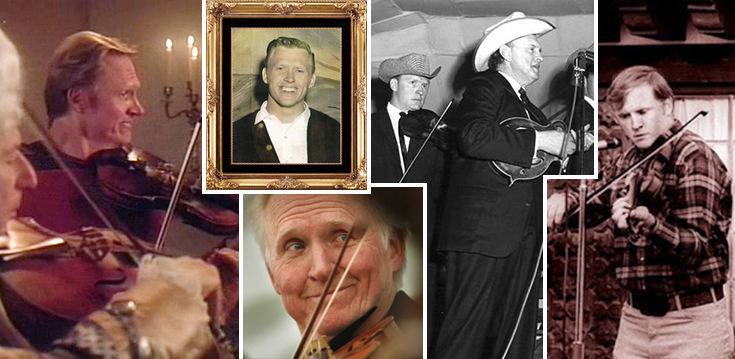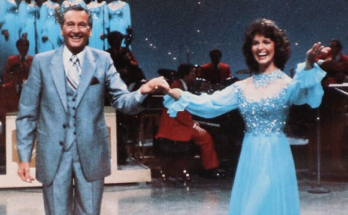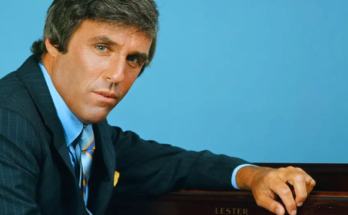

On Father’s Day 2019, my two young sons and I visited the delightful Bartlett Arboretum in Belle Plaine, Kansas, as we had numerous times before. This century-old public garden, a magical fairyland located somewhat off the beaten path, barely survived into the modern day; it might have been lost forever had it not been brought back from near-death by a founding Dixie Chick turned Sister of the Soil. It’s become a regular destination spot for our family and many others, and it’s also a wonderful place to catch a string band concert.
That day’s musical guest of honor was legendary fiddler Byron Berline, and I brought with me a copy of the first album he played on, Pickin’ and Fiddlin’ with the Dillards, released in 1965, in hopes that he might autograph it.
The boys and I spread out a blanket on the lush grass in the clearing where concerts are staged and no sooner had we sat down than I caught sight of Mr. Berline, casually sauntering toward his merch table before the show began. He spoke to someone for a moment there, and when he was finished, I introduced myself and asked for his signature.
He took the record from my hand and a faint smile tugged at one corner of his mouth. He looked at it intently, squinting just a bit against the full sun of the June afternoon, and for a couple seconds he seemed to be somewhere else.
“Wow, this one goes all the way back,” he said wistfully. “I turned 20 years old while we were in the studio making this.” He signed his name on the front with the Sharpie I provided, and I offered my condolences on the recent fire that had destroyed his iconic fiddle shop in Guthrie, Oklahoma, just about 100 miles to the south. He nodded grimly, we chatted for another minute, and then he got onstage with his band and absolutely ripped for the next hour and a half.
Late last night I heard the news that Mr. Berline, recovering from a recent stroke, had passed away the night before at age 77.
I got to thinking: This is a man with an outstanding body of work, described as “arguably America’s most influential fiddler ever” — yet outside of bluegrass fans and certain strains of music geeks, few seem to know his name. So in honor of his passing, here’s a brief tour through his remarkable life and career.
Byron Berline was born in the border town of Caldwell, Kansas in July 1944, but grew up on the Oklahoma side of the line. His family was a musical bunch and he exceled at the fiddle and mandolin, starting at age five. At school he was an athletic kid, later attending Oklahoma University on an athletic scholarship. He played football under the storied Bud Wilkinson, then switched to track and even set a javelin record before graduating with a teaching degree in physical ed.
The day of the John F. Kennedy assassination came to hold extra meaning for the young Mr. Berline, as it also happened to be the day he met the famous Dillards bluegrass group, who were playing in Oklahoma City. Better known to millions of Americans as members of the cartoonish hillbilly Darling clan on TV’s Andy Griffith Show, the Dillards jammed informally with Berline in a parking lot, then invited him to play with them onstage — and ultimately to record with them.
The Dillards had been at this time experiencing frustration with both their record company — Jac Holzman’s folky Elektra — and the sternly orthodox bluegrass crowd. The former pressured them to remain strictly traditional in their recordings and the latter didn’t consider them traditional enough. After two poorly-selling albums, the group owed Elektra one more, and they decided to go out with a bang, flying Berline out to California to join them on the most straightforward, by-the-book, old-school bluegrass record they would ever produce.
“That wasn’t a record made for anyone but the traditionals,” guitarist Rodney Dillard recalled years later. “We got completely hacked to pieces by them. So we said, ‘OK, screw you guys. We’ll make an album, and we’ll play it right up your ass!’ So we did.”
Just weeks before his 21st birthday, while still at OU, Berline entered and won the National Old Time Fiddle Contest in Weiser, Idaho, the world’s most widely recognized competition in that discipline. (He would do it again in 1970.) A few weeks later he played the Newport Folk Festival as a duo act with his father Lue (himself an old time fiddle champ). Newport that year became the stuff of legend, of course, for Bob Dylan “going electric” — but once again, a notorious historic moment took on new meaning for Berline, as this was also when and where he met the undisputed Father of Bluegrass Music, Bill Monroe, for the first time. The famously prickly Monroe took an immediate shine to young Byron and invited him to join his band as soon as he finished college. And in 1967, that’s just what he did.

Berline spent the next couple years in a whirlwind of touring, rubbing shoulders with both the Old Gods of bluegrass music — icons such as Monroe, Jimmy Martin and Flatt & Scruggs — and the form’s Young Turks, too — Gram Parsons, Clarence White, various Byrds, etc. And then one day in 1969 he got a call from no less than Keef Richards, offering to fly him out to LA to play fiddle on a track on the upcoming Rolling Stones album, on Parsons’ recommendation.
The song in question was a stripped-down reworking of the band’s then-current non-album single, “Honky Tonk Women,” rebranded as “Country Honk.” Berline dutifully ran through a couple takes in the studio, but the band decided it didn’t sound organic enough, so they asked if he would be amenable to being recorded as he stood on the damp sidewalk outside, in hopes of capturing a greasier vibe. Though Berline himself was embarrassed about a particular squeak of the bow audible in the recording, it was exactly the sort of authentic rough edge the Stones were looking for, and that is the take you hear on Let It Bleed.
While in Los Angeles for the Stones session, Berline spent time at the even-then-historic Troubadour, a popular venue that had served as Petri dish for the nascent California folk-rock scene. He started getting offers for gigs, and decided to follow the Dillards’ lead and relocate to LA himself. He barely had time to settle in before other players came sniffing around, looking to record with the hotshot young fiddler.
“The Troubadour was a big melting pot,” he recalled in a radio interview in 2019. “Every time I went down there in the evening, I don’t care what day it was, I’d get a session from it.”
Berline had come to LA just in time to take part in the groundswell of country-influenced rock music, and in his first three years in town, guested alongside many hallowed players onstage and on studio albums by the Byrds, Dillard & Clark, Nitty Gritty Dirt Band, Ron Davies, Barry McGuire & the Doctor, Crabby Appleton, Bob Ruzicka, Rick Roberts, Navasota, Mason Proffit, Stephen Stills’ supergroup Manassas and others. During this time he also became an official member of the post-Parsons Flying Burrito Brothers and started a project called Country Gazette with several similarly progressive-minded young newgrassers, too.
Being so close to Hollywood, perhaps it was inevitable that Berline would end up contributing to film scores. In 1971 he found himself working with maestro Henry Mancini on the soundtrack to Paul Newman’s sophomore directorial effort, an adaptation of Ken Kesey’s novel Sometimes a Great Notion. Not long after, he crossed paths once more with Bob Dylan, who invited him to play on his score for Sam Peckinpah’s anti-western Pat Garrett & Billy the Kid. He would go on to appear on numerous other soundtracks as a player and sometimes composer — and even onscreen in a few small film roles.
The kid from Grant County, Oklahoma was living the dream, working with heroes young and old and writing his own ticket as a first-call studio player in addition to having fun with his own projects. After leaving the more formally acoustic Country Gazette in 1975, he formed the straight-up country rock act Sundance with guitarist Dan Crary and banjo shredder John Hickman.
The next year, at a bluegrass festival in Kentucky, Berline was bowled over by the talent of a 19-year-old singing guitarist named Vince Gill, from Oklahoma City. But weeks later, when Berline tried to contact the younger man in order to audition him as a replacement Sundance singer, he realized he had no further contact information. He had to resort to cold-calling all the folks named Gill listed in the OKC phone book in hopes of finding the right number. Berline finally hit the mark when he got to Stan Gill. It would turn out to be the phone call that changed Vince Gill’s life forever; he would go on to sing and play with Sundance for the next two years or more, eventually leaving as the band dissolved to join “Amie” hitmakers Pure Prairie League.
On the heels of a small role as (surprise!) a country musician in the Bette Midler/Janis Joplin film The Rose, Berline, ever game for collaboration, put together the triple-violin-powered LA Fiddle Band, which released a blistering one-off live album in 1980. He then got back together with Sundance diaspora Crary and Hickman to form a group that would eventually come to be called California — whose sole album release, 1992’s Travelin’, earned them enough respect to win the International Bluegrass Music Association’s Instrumental Group of the Year Award three years running.
And right in the middle of all this acclaim and activity, Byron Berline slipped the surly bonds of Earth (on camera, anyway), making an uncredited cameo in a first-season episode of Star Trek: The Next Generation as a redshirt trapped in a vivid hallucination of playing violin in an 18th-century string quartet.
By the mid-1990s, the list of well-known artists with whom Berline had recorded had swollen to absurd proportion. To name just a few: Pentangle’s Bert Jansch, godhead R&B songwriter Lamont Dozier, Bill Wyman of the Stones, Arlo Guthrie, Anne Murray, Emmylou Harris (on his second instrument, mandolin), the Band, John Denver, Olivia Newton-John, the Doobie Brothers, Elton John, Rod Stewart, Victoria Williams, Matthew Sweet, Japanese rocker hide, on and on.
In 1994, the year in which Berline celebrated his 50th birthday, he released a star-studded solo album that earned him two Grammy nominations — one for the album and one for its song “Sally Goodin,” noteworthy as well for marking the first time the famously estranged Bill Monroe and Earl Scruggs had recorded together since the 1960s.
All this occurred at more or less the exact moment he decided to move back to the Sooner State and fulfill a lifelong ambition, opening the Double Stop Fiddle Shop in the small town of Guthrie. Inspired by his father’s collection of antique fiddles, Berline set about amassing one of the most impressive and valuable repositories of the instruments ever assembled. He would spend his remaining years buying, selling, trading and restoring violins going all the way back to the 1600s out of this unassuming backwoods storefront — which despite its location drew many famous musicians from all around the world.
In 1996, Berline founded the Oklahoma International Bluegrass Festival, which continues to draw an average crowd of about 15,000 each year. The proceeds from this annual event fund an ongoing music scholarship that made its first disbursement in 2008.
As the years rolled by, Berline divided his time between running his business and playing on stage and in the studio all over the world. After the fire that decimated his fiddle shop in 2019, he rolled up his sleeves, and with some help from some famous friends, got to work starting over.
“People say, ‘When are you going to retire?'” he told the Tulsa World in the wake of the blaze. “Well, what do you want me to give up, fiddling or golf? It’s a hard decision. I’m in relatively good health and there’s no use to quit, you know what I mean?”
And he never did quit. Byron Berline continued gigging and playing golf until his recent stroke slowed him down, and at the time he died last Saturday night, his band was just preparing to take the stage for one of their regular performances at his shop’s attached Music Hall.
What an amazing run, and what a legacy to leave behind. Who would have thought this Okie kid, the grandson of a dirt farmer who made the 1893 Land Run, would soar so high, but never lose touch with the people and the place that had made him who he was.




That was an enjoyable read. I’d never heard of the guy. Thanks for the write-up. (Have you considered submitting it to Rolling Stone?)
And what a surprise, you mentioned Crabby Appleton! I have their LP … it may be their ONLY LP!
Crabby Appleton actually released two albums to rave reviews, but somehow they just couldn’t get over the hump to sustainable fame and fortune. Their original LPs are not entirely rare, but the second one with the apple on the cover is worth about a $20 bill in good shape, and going up as more people start to appreciate their work — 50 years later!